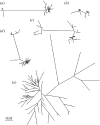Bayesian inference of population expansions in domestic bovines
- PMID: 17535790
- PMCID: PMC2111054
- DOI: 10.1098/rsbl.2007.0146
Bayesian inference of population expansions in domestic bovines
Abstract
The past population dynamics of four domestic and one wild species of bovine were estimated using Bayesian skyline plots, a coalescent Markov chain Monte Carlo method that does not require an assumed parametric model of demographic history. Four domestic species share a recent rapid population expansion not visible in the wild African buffalo (Syncerus caffer). The estimated timings of the expansions are consistent with the archaeological records of domestication.
Figures


References
-
- Bradley D.G, MacHugh D.E, Cunningham P, Loftus R.T. Mitochondrial diversity and the origins of African and European cattle. Proc. Natl Acad. Sci. USA. 1996;93:5131–5135. doi:10.1073/pnas.93.10.5131 - DOI - PMC - PubMed
-
- Bruford M.W, Bradley D.G, Luikart G. DNA markers reveal the complexity of livestock domestication. Nat. Rev. Genet. 2003;4:900–910. doi:10.1038/nrg1203 - DOI - PubMed
-
- Cockrill W.R. The water buffalo: a review. Br. Vet. J. 1981;137:8–16. - PubMed
-
- Drummond, A. J. & Rambaut, A. 2003 BEAST, v1.0. See http://evolve.zoo.ox.ac.uk/beast
-
- Drummond A.J, Rambaut A, Shapiro B, Pybus O.G. Bayesian coalescent inference of past population dynamics from molecular sequences. Mol. Biol. Evol. 2005;22:1185–1192. doi:10.1093/molbev/msi103 - DOI - PubMed
Publication types
MeSH terms
Substances
LinkOut - more resources
Full Text Sources
Miscellaneous

